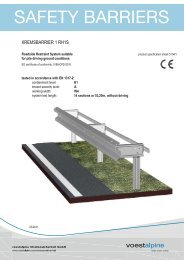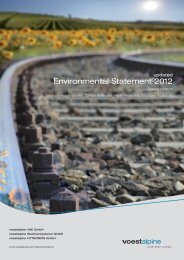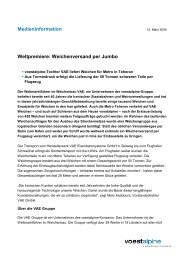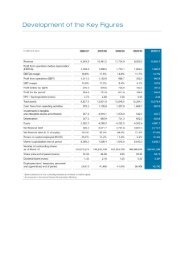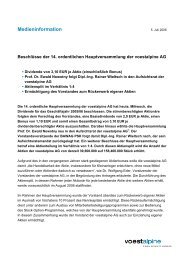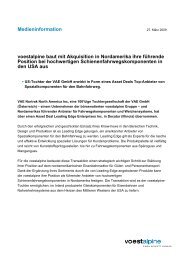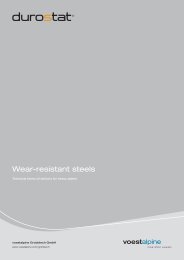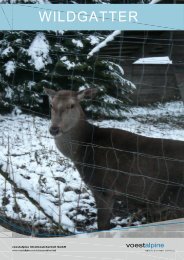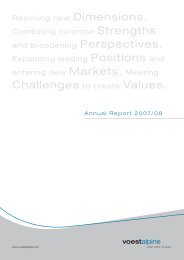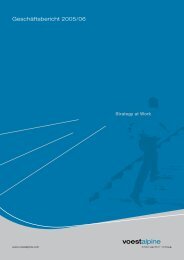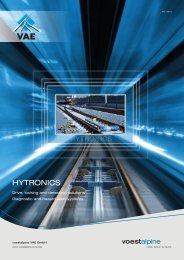Annual Report 2005/06 - voestalpine
Annual Report 2005/06 - voestalpine
Annual Report 2005/06 - voestalpine
You also want an ePaper? Increase the reach of your titles
YUMPU automatically turns print PDFs into web optimized ePapers that Google loves.
Materials costs. Incorporate all expenditures<br />
necessary for the procurement of raw<br />
and auxiliary materials to be processed by<br />
a company for resale.<br />
Net financial debt. Interest-bearing liabilities<br />
less interest-earning assets.<br />
Rating. An evaluation of the credit quality<br />
of a company recognized on international<br />
capital markets.<br />
Return on equity. The ROE is the ratio between<br />
the after-tax profit (net income) and the<br />
equity as recorded in the previous period.<br />
ROCE (return on capital employed). ROCE<br />
is the ratio of EBIT to capital employed, that<br />
is, profit generated by the capital invested.<br />
Share capital. The minimum capital requirement<br />
to be contributed by the shareholders<br />
for shares when establishing a stock corporation<br />
or limited partnership; it is issued in<br />
shares and constitutes a part of equity.<br />
Volatility. The degree of fluctuation in stock<br />
prices and currency exchange rates or in<br />
prices of consumer goods in comparison to<br />
the market.<br />
WACC (weighted average cost of capital).<br />
Average capital costs for funding with both<br />
borrowed capital and equity.<br />
Technical<br />
Blanking. An early step in preparing flatrolled<br />
steel for use by an end user. A blank<br />
is a section of sheet that has the same outer<br />
dimensions as a specified part (such as<br />
a car door or hood) but that has not yet been<br />
stamped.<br />
Blast furnace. A towering cylinder lined with<br />
heat-resistant (refractory) bricks, used by<br />
integrated steel mills to smelt iron from ore.<br />
Its name comes from the “blast” of hot air<br />
and gases forced up through the iron ore,<br />
coke and limestone that load the furnace.<br />
Bloom. A semi-finished steel form whose<br />
rectangular cross-section is more than eight<br />
inches. This large cast steel shape is broken<br />
down in the mill to produce the familiar rails,<br />
I-beams, H-beams and sheet piling. Blooms<br />
are also part of the high-quality bar manufacturing<br />
process. Reduction of a bloom to<br />
a much smaller cross-section can improve<br />
the quality of the metal.<br />
Body-in-white. Unpainted and untrimmed<br />
automotive upper body structures.<br />
Coating. The process of covering steel with<br />
another material (tin, chrome, zinc), primarily<br />
for corrosion resistance.<br />
Coils. Steel sheet that has been wound. A<br />
slab, once rolled in a hot-strip mill, can be<br />
more than one mile long; coils are the most<br />
efficient way to store and transport sheet<br />
steel.<br />
Coke. The basic fuel consumed in blast furnaces<br />
in the smelting of iron. Coke is a processed<br />
form of coal.<br />
Service<br />
Cold working (rolling). Changes in the<br />
structure and shape of steel at a low temperature<br />
(often room temperature). It is used<br />
to create a permanent increase in the hardness<br />
and strength of the steel.<br />
Continuous casting. A method of pouring<br />
steel directly from a ladle through a tundish<br />
into a mold, shaped to form billets, blooms,<br />
or slabs.<br />
Galvanized steel. Steel coated with a thin<br />
layer of zinc to provide corrosion resistance<br />
in underbody auto parts, garbage cans, storage<br />
tanks, or fencing wire. Sheet steel normally<br />
must be cold-rolled prior to the galvanizing<br />
stage.<br />
Hot dipped. Steel is run through a molten<br />
zinc coating bath, followed by an air stream<br />
“wipe” that controls the thickness of the zinc<br />
finish.<br />
Electrogalvanized. Zinc plating process<br />
in which the molecules on the positively<br />
charged zinc anode attach to the negatively<br />
charged sheet steel. The thickness of the<br />
zinc coating is readily controlled. By increasing<br />
the electric charge or slowing the speed<br />
of the steel through the plating area, the<br />
coating will thicken.<br />
Heavy plate. Steel sheet with a width of up<br />
to 200 inches and a thickness of at least<br />
5 millimeters. Mainly used for construction,<br />
heavy machinery, ship building or pipes of<br />
big diameters.<br />
Hollow sections. See “Welded tubes”<br />
<strong>Annual</strong> <strong>Report</strong> <strong>2005</strong>/<strong>06</strong><br />
1 3



